Introduction
The village Post Office closed in 2008 as part of a nationwide review by Post Office Counters. This produced a mixed reaction in Weston. For many the internet had overtaken the need for a Post Office, but to some this represented the loss of another vital community hub, where pensions could be collected, stamps purchased and news and gossip exchanged with other villagers.
What follows is a look back at the life and times of the villagers who took on the role of sub postmaster/mistress. But first let us see how the postal system established, and how Weston become part of it.
Origins of the Post Office
Historians seem in no doubt that Henry VIII laid the foundations of our postal system when, in 1516, he created a ‘Master of the Posts’ to facilitate the delivery of Court papers. The next milestone was in 1635, when Charles I allowed the public to use his ‘royal mail’ service. This marked the beginning of what would, following an Act of Parliament in 1660 under Charles II, become the General Post Office.
The first ‘local’ postal service was established in London by one William Dockwa, who set up within the city a penny post system in flagrant defiance of the monopoly on letters held by the newly formed Post Office. The Post Office soon took steps to close him down, only to promptly establish their own official ‘Post Office Penny Post’ for London, employing William Dockwa as Controller.
A network of Post Offices gradually developed in other towns and cities, but there remained large parts of the country where no postal system existed. In addition, using the post was expensive, as the cost of sending letters between towns and cities was not just one penny but related to the number of sheets of paper, but also the distance travelled. What is often not realised is that the cost of postage was paid by the receiver!
This prompted Roland Hill to introduce a uniform countrywide rate of 1 penny per half ounce, together with the then revolutionary ‘penny black’ stamp, but most importantly, paid for by the sender. This not only simplified administration, but led to a huge increase in the use of the postal system. From 67 million letters posted in 1839, this rose to 242 million following Hill’s postal reforms in 1840, increasing to over a billion by 1875.
Although many new Post Offices were opened across the country, coverage was still patchy and it was realised that it was essential to spread the availability of the service to all rural communities.A plan to broaden the postal service across the country was set up and called the ‘Rural Post Revision’, which involved Post Office representatives travelling to every village and hamlet to review postal arrangements. Although carried out between 1851 and 1859, the evidence points towards Weston being one of the first to be visited in 1851.
Weston before the Post Office
What sort of Parish was Weston in those days? Luckily, we have the 1851 Census as a guide. This lists 348 men women and children, occupying 75 dwellings, with a further 7 properties noted as uninhabited.
At the top of the social scale, 16 households employed a total of 33 servants, including 4 at the Rectory. In later years this increased to 5 with the addition of a butler, plus the gardener and his wife living in the Lodge and a married couple who looked after the horses in the Coach-house, making Rev (later Canon) Bourne the head of one of the largest (if not the largest) households in the village. By comparison, three villagers are classified as paupers.
James Kern was a Land Agent, Richard Smith and John Lane both Farm Bailiffs. Elizabeth Hickman is described as a ‘Fund Holder’ with William Grinnell a ‘Landed Proprietor’, both descriptions indicating that they were of independent means.
There were 9 farms, cultivating a total of approximately 1,400 acres, and between them employing 42 men, 9 boys and 6 women; ‘agricultural labourer’ was by far the most common occupation, followed by ‘labourer’ and ‘road worker’ or ‘road maker’. A number of women are classified as dressmakers, with one, aged 81, as a wool spinner. Transporting goods was undertaken by 1 carrier, 1 carter and 2 waggoners.
The village carpenter was Thomas Taylor, assisted by his three sons. George Puddle was a shepherd, Samuel Harris a Cordswainer ( worker in leather) and the local builder was John Tomes. Richard Jarvis the Blacksmith tenanted what is now Hartwells timber yard, John Hawkins was a ‘shopkeeper in general’, with Elizabeth Coleman another shopkeeper, malster and baker. Arthur Bagshaw was the landlord of the Seagrave Arms and his daughter, Sarah a grocer. Sarah Carnfield was the Toll Collector – the road from Bretforton, through the village up to the top of Aston Hill at Pauls Pike was a Toll Road. The shoemaker was Joseph Jarrett, the midwife Susanne Harris, and the schoolmistress Elizabeth Tomes aged 73, ran classes in her own house under the auspices of the Eden Trust, and prior to the opening of the purpose built school in 1852.
The early postmasters and mistresses
Weston in 1851 was clearly a self sufficient community, with few visitors from afar. Therefore the posse of Post Office officials arriving, presumably either on horseback or in a horse-drawn carriage, from London for the ‘Rural Postal Revision’ must have generated considerable speculation and gossip. Perhaps they booked in at The Seagrave Arms, but more likely made contact with the most influential man in the village at that time, the Rev (later Canon) Bourne, and stayed with him in some style at the Rectory.
Their task was to locate a suitable person to act as ‘Receiver of Post’, the role we would now call a sub postmaster or mistress. Candidates had to be trustworthy, and to have appropriate premises from which to operate. History does not tell us if there was competition for the post, which carried modest financial reward, but on 8th May 1851, one Sarah Bagshaw was appointed, and thus became the first sub-post mistress of Weston-sub-Edge.
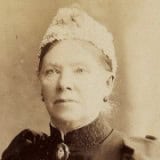 Sarah Bagshaw
Sarah Bagshaw
Who was Sarah and from where did she operate? She was born on 23 April 1826 in Alcester, the daughter of Arthur Bagshaw then a veterinary surgeon. Sarah’s first mention is in the census of 1841 when, at the age of 15, she is noted as resident in the Seagrave Arms, quite possibly as house maid to the then landlord John Barnes.
In the 1851 survey (presumably carried out prior to her appointment as sub postmistress) Sarah is noted as a grocer living separately with her sister Elizabeth. Her father is now the Landlord of the Seagrave Arms – in a later directory he is shown as both landlord and veterinary surgeon.
A trade directory in 1856 announced that ‘Letters are delivered at 9 a.m. & dispatched at half past 3 p.m.’ . But where was the first post office located? Perceived wisdom has been that the Post Office originated in what we now call ‘Popfosters’, but a map of the village prepared in 1853 to reflect the impact of the Enclosure Acts suggests that Sarah ran her Post Office from what is now known as Dovers Cottage which was then divided into two dwellings.
Sarah is not listed as a Weston resident in the 1861 census, with the ‘Post Office’ (wherever that was) occupied by timber merchant Charles Butler. Henry Dolpham is defined as a ‘Rural Postman’. Sarah can now be found living in Bidford upon Avon with her husband Sylvester Sill, a grocer, but in the Post Office Directory of 1863, she is still listed as the sub postmistress for Weston. Very strange!
By 1871 the post mistress is now Christiana Jarrett, the second wife of Joseph Jarrett, the shoemaker. In 1881 Joseph is noted as the postmaster and also parish clerk. Ten years later, Joseph’s son John is now the parish clerk and his wife Rose, the postmistress. Unfortunately, it is not known where these people operated their Post Offices, but the 1891 census also confirms that James Hamilton was a Postmaster. We know that James was then living at what is now known as ‘Popfosters’, suggesting the Post Office had by then transferred to that address, with perhaps Rose assisting with the transfer.
The Hamilton Family
Who was James Hamilton? He was born in Weston in 1836 and is most probably the ‘James Hambleton ‘ aged 5, first mentioned in the 1841 Census. He married 21 year old Ellen Washburn of Aston Cantlow in 1866, but strangely, only James is noted as a resident in Weston in 1871, with Ellen although married, living as housekeeper to her brother in Aston Cantlow accompanied by her daughters Elizabeth aged 3 and Ann aged 1 (both born in Aston Cantlow).
In 1881, James and Ellen are together in Weston, along with their daughters Elizabeth, now 13, Harriett aged 9, Georgina aged 7 Louise aged 5, Emma aged 3 and Martha May just 10 months old. Sadly Anne had passed away in 1874, but Susan was born in 1883.
James had started his working life as an agricultural labourer, but progressed to shopkeeper and as mentioned above, in the 1891 Census he is recorded as Post Master. Ten years later he was still in charge, but then aided by his 23 year old daughter Emma. He was still in post in 1911, but now assisted by daughter Louise.
It was Louise who finally took over as Post Mistress. After her marriage to Arthur Gould, she was still known to all as ‘Miss Hamilton’. In her book on the village, Doris Court describes the large glass jars full of boiled sweets sitting in the front window and Miss Hamilton waiting patiently while a child decided which sweets to buy for a penny.
We have another eyewitness account of the Post Office during these early years, recorded by Major Patrick Webb in his memoirs. When Patrick and his family moved to Weston in 1926, Broadway was their ‘post town’, making their postal address Worcestershire, although the village was in Gloucestershire. The transfer to Chipping Campden was made some years later. According to Major Webb the village postman was called Green, who wore the smart blue postal uniform, including a flat-topped helmet with peak to both front and rear. Patrick describes the post office as ‘little’ and ‘dingy’, but that Louise had a heart of gold.
Mrs Gould (aka Miss Hamilton) ran the shop and Post Office in Church Street until her death in 1956, aged 80. The property was then bought and occupied by Jack Foster following his retirement as landlord of the Seagrave Arms. Legend has it that he had the property refurbished and when work in the roof was being carried out, a monks hideout was discovered.
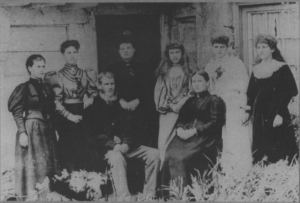
The Hamilton Family.
Front Row : James and Ellen
Back Row: (from left to right) Harriett, Louisa, Emma, Sue, Nell and May.
Popfosters
Thereafter, the former Post Office became known as ‘Popfosters’ and has been owned by a number of families. One past occupant, Hugh Bowen-Morris, merits a mention.
Hugh was a Spitfire pilot in the Battle of Britain, and is credited with downing at least two enemy aircraft and sharing in a third. However, his luck ran out in June 1942 when, during a convoy protection sortie off France, a canon shell exploded in his cockpit, rendering his right arm useless. He managed to carry out a forced landing in enemy territory before losing consciousness. He was taken to the Lufwafffe hospital at St Omer where his right arm was amputated. Hugh was repatriated by the Red Cross in an exchange of prisoners in 1943. After the war Hugh returned to his profession of accountant, and in spite of his handicap, subsequently served on the Board of John Brown Shipbuilders. Upon retirement, Hugh and his wife Pauline moved to Popfosters until Hugh’s untimely death in !991 at the age of only 71. Hugh is buried in the village churchyard, where his headstone bears the fitting tribute: ‘One of the Few.’
Endon House
For many years this property, then occupied by Fred and Elizabeth Cole, had been the location of a Tea Room in the back garden. Before the war, cyclists took advantage of this facility , and Endon House was duly registered in the CTC (Cyclist Touring Club) handbook – the 1939 edition makes interesting reading with Endon House competing with the Seagrave Arms and the Hamiltons at the then Post Office. Tea, which comprised tea, bread and butter, green stuff in season, preserve and cake, cost 1/- at all three locations. Bed and breakfast was 3/6 at both Endon House and the Post Office, but 5/6 at the Seagrave, although that included a free bath!
Following the outbreak of WW2, and the construction of RAF Honeybourne, the Tea Rooms, run by Elizabeth Cole, became known as ‘Smokey Joe’s’, where airmen could buy a cup of tea in a jam-jar and toast with dripping or jam all for a few pence. After the war, Elizabeth continued to run the Tea Rooms in the garden (with cyclists still being regular customers) together with a shop in a lean-to on the side of the house.
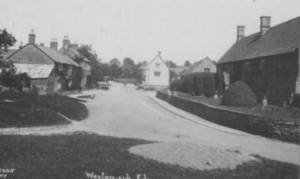
Following the death of Louise Gould (nee Hamilton) in 1956, the Post Office was transferred from Popfosters to Endon House, which was then occupied by Joyce and Cyril Cole, with Joyce taking over as sub-postmistress. Their existing shop was also relocated indoors from the lean-to which was then demolished. In 1964 Planning Permission was secured to convert the Post Office and shop back to a sitting room, and to move the business into Smokey Joe’s, which was upgraded with a new shop front in reconstructed stone. This brought to an end the availability of the cyclists ‘club run tea stop’.
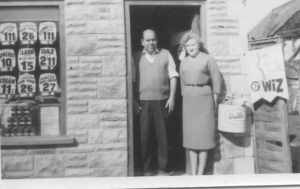 Cyril & Joyce Cole
Cyril & Joyce Cole
Cyril and Joyce Cole sold the house and business in 1970 to Alf and Daisy Golby, who traded until 1977, when they retired.
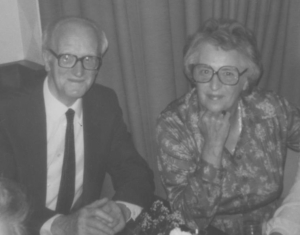 Alf & Daisy Golby
Alf & Daisy Golby
The business was then taken over by Geoffrey Abel who ran it until 1995. His decision to retire and close the shop prompted a village meeting when it was agreed overwhelmingly that efforts should be made to find alternative premises and a new sub postmaster or mistress.
Forge House
Valerie Kemp, who had served in the shop and Post Office for a number of years, agreed to take on the role – this just left the far from straightforward task of locating an alternative site. To the rescue came Peter Hartwell, who offered part of the garage in Forge House, and after the necessary Planning Permission had been obtained, construction commenced in time for the office to open on 27th March 1995. Service resumed as usual, albeit on slightly reduced hours. The new Post Office could only be described as ‘compact’, but the bench provided outside allowed the older villagers to sit and chat while waiting to collect their pensions.
However, there was a gradual erosion of transactions that could be carried out, together with a reduction in footfall due to the increasing impact of the internet. As such, when Weston was included in a proposed closure programme in 2008, it was difficult to argue with the conclusion that the office had become uneconomic. The doors finally closed on 6th June 2008, with the Post Office premises handed back to Liz & Paul Heneghan, who had taken over responsibility for the Hartwell wood yard, following the retirement of Peter Hartwell. The area used for the Post Office now acts as the entrance hall to the ‘Post Box Flat’.
For the record, Weston had the benefit of a Post Office, in its various locations, for a period of 157 years and 29 days.
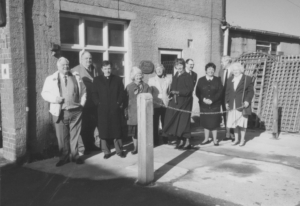
Post Office opening at Forge House 27th March 1995
From left to right: Jim Court, Peter Hartwell, PO official, Doris Court, Mary Knight, PO Official, PO Official, Valerie Kemp, Geoffrey Abel, Joyce Cole.
The Horizon Computer System
This history of the village Post Office would not be complete without reference to ‘Horizon’, the flawed computer system that led to the wrongful conviction of so many sub postmasters and mistresses. When Valerie opened her ‘one woman’ office, she had a large paper ledger ( that she called her ‘spellbook’ ) in which to record her daily transactions and that had to be balanced every Wednesday. This was soon replaced by Horizon which did operate satisfactorily most of the time. However, it sometimes misbehaved and assistance had to be sought from a ‘help’ line. Fortunately the system never threw up an unexplained cash shortfall. Had it done so, it is frightening to imagine the consequences, given the Post Office’s determination to maintain the ‘integrity’ of their system at all costs.
—————–
